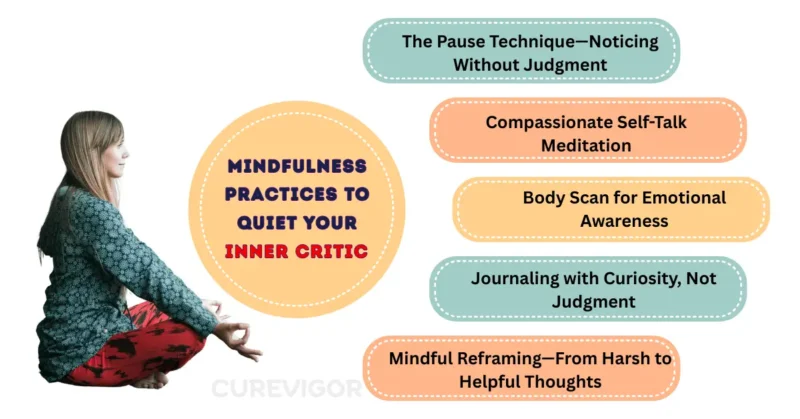Learn how to silence your inner critic, go beyond affirmations, and build lasting self-compassion through awareness and kindness.
Thank you for reading this post, don't forget to subscribe!How Mindfulness Practices Silence Your Inner Critic for Good
You know that voice in your head that constantly says, “You’re not good enough,” or “You always mess things up”? That’s your inner critic—a mental habit that most of us carry without realizing it.
It judges, compares, and reminds you of every flaw or failure. While it often develops as a way to protect you from mistakes, over time, it becomes one of the biggest blocks to confidence, creativity, and peace of mind.
Many people turn to positive affirmations to overcome negative self-talk. Saying phrases like “I am enough” or “I am confident” can feel uplifting for a moment.

But if deep down you don’t believe them, those words can ring hollow. Affirmations alone rarely silence that harsh inner voice because they address the surface, not the root.
The true change occurs when you begin to watch your thoughts rather than resisting them; here is when mindfulness comes into play.
You can gradually change how you interact with yourself by practicing mindfulness, which enables you to see your critic without passing judgment.
In this article, you’ll discover five powerful mindfulness practices that go beyond affirmations and help you silence your inner critic for good.
Why Affirmations Sometimes Fall Short
The purpose of affirmations is to substitute good ideas with negative ones. However, if your subconscious mind holds a deep belief, such as “I’m not worthy,” repeating “I’m confident and successful” might actually create inner resistance. You end up arguing with yourself.
This happens because affirmations try to override negative thinking rather than understanding it. The mind resists change when it feels forced.
You might even experience the “affirmation backlash”—feeling worse after saying something you don’t truly believe.

Mindfulness takes a different path. Instead of pretending those negative voices don’t exist, it teaches you to notice, listen, and release them.
You become aware of your inner critic without identifying with it. Once you observe those patterns without judgment, they begin to lose power.
5 Proven Mindfulness Practices to Quiet Your Inner Critic
Now, let’s explore five proven mindfulness practices to gently and naturally quiet your inner critic.
1. The Pause Technique—Noticing Without Judgment
Silencing your inner critic begins with this straightforward yet important step: pause and notice.
Every time that harsh voice appears—maybe it says, “You’re so lazy,” or “You’ll never get this right”—pause for a moment before reacting. Take a slow breath in and out. Ask yourself, “Who is speaking right now?”
Often, you’ll realize that it’s not the real you speaking. It’s a conditioned voice—maybe something you learned from parents, teachers, or past failures. When you recognize it as just a thought pattern, you can choose not to believe it.
Here’s a mini-practice you can try:
- When a self-critical thought appears, stop what you’re doing for five seconds.
- Breathe in deeply, feeling your belly rise.
- Silently say, “I notice this thought, but I don’t have to believe it.”
- Exhale slowly and return to the present moment.
This tiny pause rewires your brain over time. You start responding with awareness instead of reacting automatically. The inner critic loses its grip when it’s met with observation instead of obedience.
Tip: You can even give your critic a name—like “The Perfectionist” or “Ms Doubt.” This makes it easier to recognize when it shows up without taking it personally.
2. Compassionate Self-Talk Meditation
Mindfulness isn’t just awareness—it’s also kind awareness. Compassion is what transforms observation into healing.
During a self-compassion meditation, you intentionally replace harsh self-talk with understanding and warmth. Instead of saying, “I’m such a failure,” you practice responding like you would to a close friend: “I’m having a hard time right now, but I’m doing my best.”
Here’s a simple five-minute meditation:
- Sit comfortably and close your eyes.
- Take a few deep breaths to settle.
- Place a hand on your chest. Feel your heartbeat.
- Silently repeat:
- “May I be kind to myself?”
- “May I accept myself as I am.”
- “May I forgive my mistakes.”
Don’t worry if it feels awkward at first—most people aren’t used to talking kindly to themselves. But the more you practice, the more your brain learns to default to compassion instead of criticism.
Research shows that self-compassion reduces anxiety, depression, and self-blame, helping you bounce back faster from challenges. Over time, you’ll notice that inner voice softening—because you’re teaching it a new tone: kindness.
Mindful Reminder: Self-compassion isn’t about letting yourself off the hook; it’s about treating yourself like a human being who’s learning and growing.
3. Body Scan for Emotional Awareness
Your inner critic doesn’t only live in your mind — it also shows up in your body. Tight shoulders, clenched jaws, or a heavy chest are often physical signs of internal judgment or pressure.

A body scan meditation helps you reconnect with your body and release the tension that negative thoughts create. By paying attention to sensations, you shift from thinking to feeling, from criticism to compassion.
Here’s how to do it:
- Sit or lie down comfortably. Close your eyes.
- Start by focusing on your feet. Notice any tingling, warmth, or heaviness.
- Slowly move your focus upward — through your legs, stomach, chest, shoulders, and face.
- Wherever you feel tension, breathe into that spot. Imagine your breath melting away the tightness.
- If you notice judgmental thoughts (“Why can’t I relax?”), Gently return to the body sensation.
This practice trains you to stay present and curious, even in the face of discomfort. You realize your feelings are temporary, not your identity. That awareness breaks the cycle of internal criticism and helps you build emotional resilience.
Tip: Doing a quick 2-minute body scan before bed or during stressful moments can instantly reset your mood.
4. Journaling with Curiosity, Not Judgment
Writing can be a powerful form of mindfulness—but only if done with curiosity instead of self-blame. Most people journal to vent their frustrations, but mindful journaling means observing your thoughts with kindness.
Try this simple method called Reflective Mindful Journaling:
- Write down what your inner critic said today. Example: “You’re not doing enough.”
- Ask yourself, “What is my critic trying to protect me from?”
- Maybe it’s trying to prevent embarrassment or failure.
- Thank it for its concern, but remind it that you’re safe now.
- Rewrite the message in a supportive way: “I’m learning to take one step at a time.”
This practice builds self-awareness and emotional intelligence. You start understanding the fears behind your criticism. Often, your inner critic isn’t evil—it’s scared. When you meet it with curiosity, it begins to relax.
Prompt ideas:
- “What would I say to a friend who felt this way?”
- “What do I need to hear right now?”
- “What did I do well today, even if it was small?”
Mindful journaling transforms your notebook into a mirror of growth, not guilt.
5. Mindful Reframing—From Harsh to Helpful Thoughts
Once you’ve learned to notice and understand your inner critic, the next step is reframing—gently transforming negative thoughts into realistic, supportive ones.
Unlike toxic positivity, mindful reframing doesn’t deny what’s wrong; it simply finds a kinder truth.
Here’s how you can practice:
| Inner Critic Thought | Mindful Reframe |
| “I’m terrible at this.” | “I’m still learning. Every skill takes time.” |
| “I messed up again.” | “Mistakes show that I’m trying and improving.” |
| “People will judge me.” | “Some might, but I’m proud that I showed up.” |
| “I should have done better.” | “I did what I could with what I knew then.” |
Mindful reframing uses acceptance and growth rather than denial or shame. It teaches your brain to look for balance and perspective.
You can even say the reframe aloud or write it on sticky notes as daily reminders. Over time, your mental language becomes softer and wiser.
Quick Practice:
Next time you notice a self-critical thought, ask, “Is this thought helpful or hurtful?” If it’s hurtful, reframe it to something you’d say to someone you care about.
Bonus Tip: Mindful Breathing for Instant Calm
Sometimes, your inner critic becomes loud at the worst moments—before a presentation, during a mistake, or late at night. When that happens, your breath is your best anchor.
Try the 4-7-8 breathing technique:
- Inhale for 4 seconds.
- Hold for 7 seconds.
- Exhale slowly for 8 seconds.
- Repeat 3–4 times.
This activates your body’s relaxation response, quiets mental noise, and grounds you in the present. You can do it anywhere—while waiting, walking, or even working.
Breathing mindfully reminds you that peace isn’t something to find; it’s something you return to.
FAQs
Q. What are the seven types of inner critics?
The seven main types of inner critics are:
- The Perfectionist, who demands flawlessness
- The Taskmaster, who pushes you to work harder
- The Underminer, who discourages risk
- The Destroyer, who attacks your self-worth
- The Guilt-Tripper, who blames you for past actions
- The Conformist, who fears standing out
- The Controller, who tries to manage emotions or situations.
Each critic has a protective purpose rooted in fear or past experiences. Recognizing which one dominates helps you respond with mindfulness rather than submission.
Q. How do I silence my inner critic?
To silence your inner critic, start by noticing when it speaks—awareness breaks its automatic control. Use mindful pauses to breathe and separate from the thought rather than believing it.
Then, replace judgment with self-compassionate statements, such as “I’m learning” or “I’m enough.” Practices like meditation, journaling, and mindful reframing help soften its tone.
Over time, consistent mindfulness transforms that inner voice from harsh to helpful.
Q. How do I stop criticizing myself?
Stopping self-criticism begins with acceptance, not resistance. Instead of scolding yourself for being negative, pause and ask, “What fear or need is behind this thought?”
Treat yourself with the same patience you’d offer a close friend. Daily habits like gratitude journaling, mindfulness, and gentle self-talk retrain your brain toward kindness.
Remember, self-criticism fades naturally when you build emotional safety and self-trust through compassionate awareness.
Q. How do you silence a critic?
Whether the critic is internal or external, silence it by staying grounded in your truth. Don’t argue or defend—instead, pause, breathe, and observe the feedback mindfully. If it’s your inner critic, question its evidence: “Is this fact or fear?”
If it’s from others, recognize that criticism often reflects their perspective, not your value. Respond calmly or simply walk away. True silence comes from self-assurance, not confrontation.
Q. What triggers inner critics?
Inner critics are often triggered by stress, fear of failure, or comparison. They surface when you face new challenges, seek approval, or revisit old insecurities.
Childhood experiences, perfectionist tendencies, and societal pressures can strengthen that voice. Even fatigue or emotional overload can make it louder.
Mindfulness helps you identify triggers early so that you can respond with calm awareness instead of self-blame.
Q. Is it true that 50% of people don’t have an inner monologue?
Yes, research suggests that roughly half of people don’t experience an ongoing verbal inner monologue. Instead, they may think in images, emotions, or abstract impressions rather than words.
This doesn’t mean they lack self-reflection—their inner experience simply takes a different form. For those without a verbal critic, self-judgment may manifest as tension, anxiety, or discomfort rather than mental dialogue.
Mindfulness still helps, as it trains awareness of whatever form thoughts take.
Q. Can mindfulness really change negative thinking?
Yes—mindfulness can genuinely rewire your brain to think more positively. Scientific studies show that regular mindfulness practice reduces activity in the brain’s fear center (the amygdala) and increases activity in areas linked to self-awareness and emotional control.
By observing thoughts without reacting, you weaken the grip of negativity. Over time, mindfulness replaces automatic criticism with calm awareness and understanding. The result is not forced positivity but genuine inner balance.
Q. How long does it take to quiet your inner critic?
There’s no fixed timeline, but most people notice subtle changes in just a few weeks of consistent practice. As your level of mindfulness increases, you become more aware of criticism and respond to it more patiently.
It may take months of patient awareness to achieve deep transformation, where the critic becomes a serene inner guide.
Remember, the goal isn’t to erase the critic but to change your relationship with it through daily mindfulness, compassion, and reflection.
Q. Why is the inner critic louder at night or under stress?
Your inner critic often grows louder when you’re tired, anxious, or overwhelmed. At night, distractions fade and unprocessed thoughts surface, giving the critic space to speak.
Stress triggers your survival instinct, which amplifies fear-based thinking like “What if I fail?” or “I’m not good enough.” Mindful breathing, grounding exercises, and journaling before bed help calm the mind and reduce this late-night mental chatter.
Conclusion
Your inner critic may never disappear completely — and that’s okay. Its voice once tried to keep you safe. But now you have tools to lead that voice with awareness, compassion, and wisdom.
Although affirmations can serve as lovely reminders, mindfulness provides them with a foundation. It turns surface positivity into a deep transformation.
By practicing these five mindfulness techniques — pausing, showing compassion, tuning into your body, journaling curiously, and reframing with awareness — you build a gentler inner world.
The more you practice, the quieter your critic becomes. In its place grows a calm, confident voice that says, “I trust myself. I am growing. I am enough.”
Remember:
When you meet your thoughts with mindfulness, even your inner critic learns to speak with kindness.
Read more Health and Wellness Tips.
You might love:


